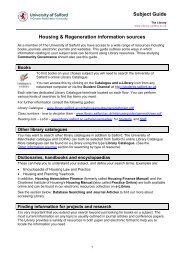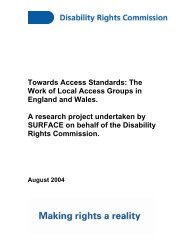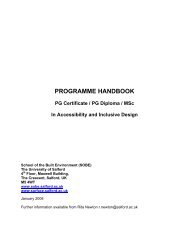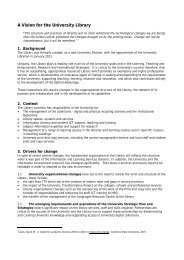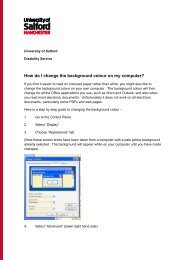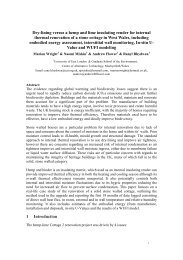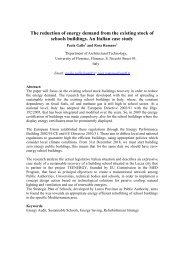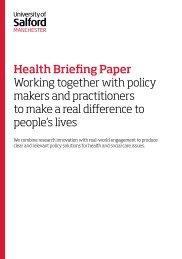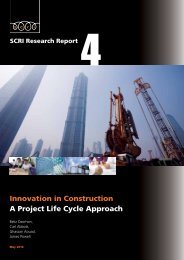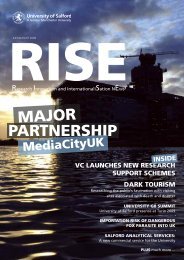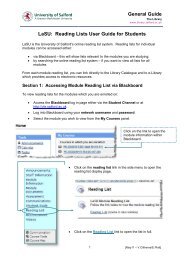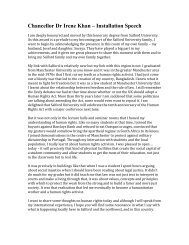Download a copy (pdf) - University of Salford
Download a copy (pdf) - University of Salford
Download a copy (pdf) - University of Salford
Create successful ePaper yourself
Turn your PDF publications into a flip-book with our unique Google optimized e-Paper software.
ArtsWith experimental poetry becoming increasingly popular, and alternativedance classes springing up in church halls and community centresacross the country, new research is examining the close links betweenmovement and language.Poetry in motionMac Low's 40 dancers (© Ian Douglas, used with permission)Last September, Dr ScottThurston, a Senior Lecturer inEnglish and Creative Writing,visited New York as part <strong>of</strong> the50th anniversary celebrations <strong>of</strong>the Judson Dance Theater. Thispioneering studio championedthe concept <strong>of</strong> multi-disciplinary arts, includingwork by the likes <strong>of</strong> Yoko Ono and John Cage,who went on to become huge internationalartists.“The New York art scene in the 1960s wascharacterised by multi-generic work,” saysThurston, “with dancers, musicians, poets,artists and film-makers working in collaborationto produce films and performances.”Thurston, who is based at the School <strong>of</strong>Humanities, Languages and Social Sciences, wasamazed to see such huge audiences watchingperformances <strong>of</strong> pieces like The Pronouns:A Collection <strong>of</strong> 40 Dances for the Dancers.The piece features a series <strong>of</strong> ‘dance-instruction’poems by the poet Jackson Mac Low (b.1922), which were composed algorithmicallyusing 56 index cards, each bearing one to fivedifferent actions. As befitting experimental art,says Thurston: “There were a wide range <strong>of</strong>interpretations, some <strong>of</strong> which were very closeto the words on the page, and some which werecompletely abstract responses to those pieces.They were written to be performed but it’svery open as to how you interpret them.” Andnow he believes we could see similar interest inBritain, too.“There was a period in the 60s and 70s whenexperimental poetry was more visible over here,”he explains, “but it’s been ‘underground’ for thelast 40 years.“Now, work that has previously been seenas more marginal is reaching a wider poetryaudience and people are beginning to take more<strong>of</strong> an interest in non-traditional approaches,”he continues. “I think things are poised to goalmost mainstream in the UK too, so now seemsto be the perfect time to explore the connectionbetween postmodern dance and experimentalwriting.”Thurston’s research is part <strong>of</strong> a bigger enquiryinto genre and how different art forms <strong>of</strong>tenwork together, such as poetry and dance, poetryand visual art and dance and sculpture. It willfeed directly into the <strong>University</strong> as part <strong>of</strong> theMA Creative Writing: Innovation and Experimentcourse, and Thurston has also lectured on hisfindings at both Edinburgh and Bedfordshireuniversities, and performed his creative work atLiverpool’s famous Bluecoat Arts Centre.“The research is generating important newknowledge about the field, and furthers the<strong>University</strong>’s reputation as a research-informedinstitution that produces original work,” heexplains. Thurston is also exploring ways inwhich writing and language can be linked to thepractice <strong>of</strong> movement therapy which, amongmany things, can be used to help people sufferingfrom depression and emotional problems.To find out more about research in thehumanities and the MA in Creative Writing,visit: www.salford.ac.uk/humanitiesMay 2013 | 9



